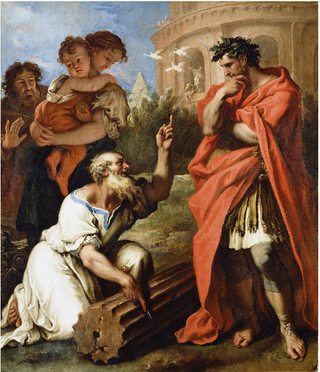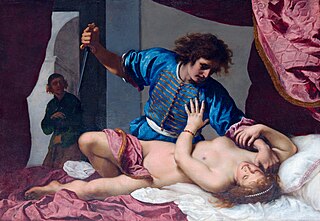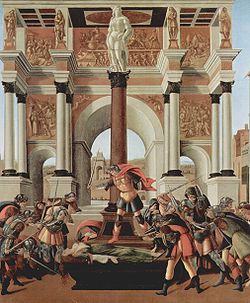
Lucius Tarquinius Superbus was the legendary seventh and final king of Rome, reigning 25 years until the popular uprising that led to the establishment of the Roman Republic. He is commonly known as Tarquin the Proud, from his cognomen Superbus.

According to Roman tradition, Lucretia, anglicized as Lucrece, was a noblewoman in ancient Rome. Sextus Tarquinius (Tarquin) raped her and her subsequent suicide precipitated a rebellion that overthrew the Roman monarchy and led to the transition of Roman government from a kingdom to a republic. After Tarquin raped Lucretia, flames of dissatisfaction were kindled over the tyrannical methods of Tarquin's father, Lucius Tarquinius Superbus, the last king of Rome. As a result, the prominent families instituted a republic, drove the extensive royal family of Tarquin from Rome, and successfully defended the republic against attempted Etruscan and Latin intervention.

Lucius Junius Brutus was the semi-legendary founder of the Roman Republic, and traditionally one of its first consuls in 509 BC. He was reputedly responsible for the expulsion of his uncle the Roman king Tarquinius Superbus after the suicide of Lucretia, which led to the overthrow of the Roman monarchy. He was involved in the abdication of fellow consul Tarquinius Collatinus, and executed two of his sons for plotting the restoration of the Tarquins.
Sic semper tyrannis is a Latin phrase meaning "thus always to tyrants". In contemporary parlance, it means tyrannical leaders will inevitably be overthrown. The phrase also suggests that bad but justified outcomes should, or eventually will, befall tyrants. It is the state motto of Virginia.

The Rape of Lucrece (1594) is a narrative poem by William Shakespeare about the legendary Roman noblewoman Lucretia. In his previous narrative poem, Venus and Adonis (1593), Shakespeare had included a dedicatory letter to his patron, the Earl of Southampton, in which he promised to compose a "graver labour". Accordingly, The Rape of Lucrece has a serious tone throughout.

Publius Valerius Poplicola or Publicola was one of four Roman aristocrats who led the overthrow of the monarchy, and became a Roman consul, the colleague of Lucius Junius Brutus in 509 BC, traditionally considered the first year of the Roman Republic.

The gens Tarquinia was a plebeian family at ancient Rome, usually associated with Lucius Tarquinius Priscus and Lucius Tarquinius Superbus, the fifth and seventh Kings of Rome. Most of the Tarquinii who appear in history are connected in some way with this dynasty, but a few appear during the later Republic, and others from inscriptions, some dating as late as the fourth century AD.
Demaratus, frequently called Demaratus of Corinth, was the father of Lucius Tarquinius Priscus, the fifth King of Rome, the grandfather or great-grandfather of Lucius Tarquinius Superbus, the seventh and last Roman king, and an ancestor of Lucius Junius Brutus and Lucius Tarquinius Collatinus, the first consuls of the Roman Republic.

Sextus Tarquinius was one of the sons of the last king of Rome, Lucius Tarquinius Superbus. In the original account of the Tarquin dynasty presented by Fabius Pictor, he is the second son, between Titus and Arruns. However, according to Livy and Dionysius of Halicarnassus, he was either the third or first son, respectively. According to Roman tradition, his rape of Lucretia was the precipitating event in the overthrow of the monarchy and the establishment of the Roman Republic.

Lucius Tarquinius Ar. f. Ar. n. Collatinus was one of the first two consuls of the Roman Republic in 509 BC, together with Lucius Junius Brutus. The two men had led the revolution which overthrew the Roman monarchy. He was forced to resign his office and go into exile as a result of the hatred he had helped engender in the people against the former ruling house.

Spurius Lucretius Tricipitinus is a semi-legendary figure in early Roman history. He was the first Suffect Consul of Rome and was also the father of Lucretia, whose rape by Sextus Tarquinius, followed by her suicide, resulted in the dethronement of King Lucius Tarquinius Superbus, therefore directly precipitating the founding of the Roman Republic. It is believed that Lucretius and his accomplishments are at least partly mythical and most ancient references to him were penned by Livy and Plutarch.

The gens Lucretia was a prominent family of the Roman Republic. Originally patrician, the gens later included a number of plebeian families. The Lucretii were one of the most ancient gentes, and the second wife of Numa Pompilius, the second King of Rome, was named Lucretia. The first of the Lucretii to obtain the consulship was Spurius Lucretius Tricipitinus in 509 BC, the first year of the Republic.

Portrait of Tommaso Inghirami is an oil painting by Italian artist Raphael. Painted ca. 1509, it exists in two copies, one of which is in display in the Palatina Gallery of Palazzo Pitti in Florence and the other in the Isabella Stewart Gardner Museum in Boston. Known for its realism and attention to detail, the image is reminiscent of works by Hans Holbein the Elder, by whom Raphael may have been influenced in its execution. Stylistically, it relates to Raphael's Portrait of Agnolo Doni, ca.1506, in what Claudio Strinati described in 1998 as its "merciless clarity."

The Tarquinian conspiracy was a conspiracy amongst a number of senators and leading men of ancient Rome in 509 BC to reinstate the monarchy, and to put Lucius Tarquinius Superbus back on the throne. The conspirators were discovered and executed. The story is part of Rome's early semi-legendary history.

The Temptations of Christ is a fresco by the Italian Renaissance painter Sandro Botticelli, executed in 1480–1482 and located in the Sistine Chapel, Rome.

Tarquin and Lucretia is an oil painting by Titian completed in 1571, when the artist was in his eighties, for Philip II of Spain. It is signed, and considered to have been finished entirely by Titian himself. It is one of a series of great works from Titian's last years, but unlike some of these, is fully finished. It is now in the Fitzwilliam Museum in Cambridge, England.
The overthrow of the Roman monarchy was an event in ancient Rome that took place between the 6th and 5th centuries BC where a political revolution replaced the then-existing Roman monarchy under Lucius Tarquinius Superbus with a republic. The details of the event were largely forgotten by the Romans a few centuries later; later Roman historians presented a narrative of the events, traditionally dated to c. 509 BC, but it is largely believed to be fictitious by modern scholars.

Virgin and Child with an Angel also known as Our Lady of the Eucharist is a painting in tempera on wood panel by the Italian Renaissance master Sandro Botticelli, executed in c. 1470. It is now held by the Isabella Stewart Gardner Museum in Boston, Massachusetts, having been acquired from Prince Chigi in 1899. The painting measures 85.2 × 65 centimetres (33.5 × 25.6 in) and is one of a series of paintings of the Madonna produced by Botticelli between 1465 and 1470. It shows influences from Filippo Lippi's Virgin and Child with Two Angels of c. 1465 in the Uffizi.

Scenes from the Life of Saint Zenobius is a series of paintings by the Italian Renaissance artist Sandro Botticelli. Four panels from the series survive, which are now in three different museums. Each depicts three or more incidents from the life of Zenobius, an early Bishop of Florence who perhaps died in 417. The works are all in tempera on wood, and around 66 cm (26 in) high, though their length varies rather more, from about 149 to 182 cm.

The Rape of Lucretia is any of several paintings, variations of the same subject, which are usually attributed to either Felice Ficherelli or Guido Cagnacci and dated to the late 1630s or about 1640.

















